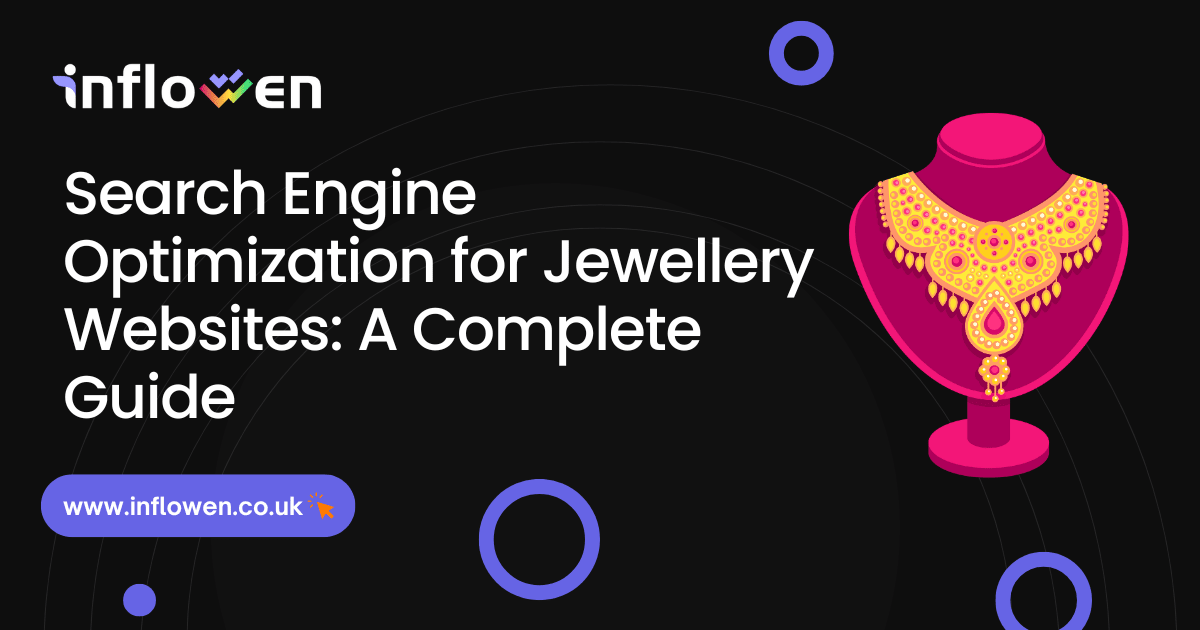Jewellery SEO is the process of optimizing online jewelry stores and local jeweler websites to increase visibility, attract qualified buyers, and drive more sales. In today’s highly competitive market, appearing on the first page of Google isn’t optional—it’s essential for brand survival and growth.
This guide explores every part of jewellery SEO: from keyword research and site structure to technical fixes, content marketing, and local optimization. It also addresses challenges unique to jewelers, predictive queries like “Is jewellery SEO worth it in 2025?”, and cost expectations. By the end, you’ll understand how to build a strategy that wins both traffic and conversions.
Table of Contents
What is Jewellery SEO?
Jewellery SEO is the practice of optimizing a jewelry business website—whether ecommerce or local—for higher search engine rankings, better visibility, and stronger online sales. It involves on-page optimization, keyword targeting, technical improvements, content creation, and off-page strategies like backlinks and reviews.
Is Jewellery SEO Worth It in 2025? Yes, jewellery SEO is worth it in 2025 because customer journeys increasingly start with search. According to BrightEdge, 68% of online experiences begin with a search engine. With rising competition from luxury brands and marketplaces, jewelers who neglect SEO risk losing visibility to competitors who invest strategically.
Why Jewellery SEO Matters for Businesses
SEO is vital for jewelry businesses because customers rely on Google, Bing, and other search engines to find engagement rings, necklaces, and luxury gifts. Without optimization, even the most stunning collections may remain invisible.
Key benefits include:
- More qualified leads – SEO drives buyers actively searching for jewelry.
- Higher ROI – Organic traffic delivers long-term results compared to paid ads.
- Local visibility – Optimization helps jewelers rank for searches like “jewelry store near me.”
- E-commerce growth – Proper SEO ensures product pages compete with giants like Tiffany, Blue Nile, and Etsy.
How to Create an SEO Strategy for a Jewellery Business?
Building an SEO strategy for jewelry businesses requires a structured, step-by-step approach. From technical audits to content marketing, each action strengthens visibility in a competitive industry. Below are the 15 essential steps jewelers should follow.
1. Start with an SEO Audit (If You Have an Existing Site)
An SEO audit is the first step to uncover issues preventing your jewelry website from ranking. It checks site health, crawlability, indexation, and broken links. For jewelers, audits often reveal duplicate product pages, thin category descriptions, or slow site speeds caused by heavy image files. Use tools like Screaming Frog, Ahrefs Site Audit, or SEMrush to diagnose problems before scaling optimization.
2. Research Your Keywords
Jewelry keyword research should balance broad terms like “engagement rings” with long-tail queries such as “rose gold engagement rings online USA.” Tools like Google Keyword Planner and Ahrefs highlight demand and search intent. Seasonality matters—searches spike during Valentine’s Day, Christmas, and wedding seasons. Incorporating local modifiers (“jewelry store in Dallas”) also captures high-intent customers near your store.
3. Analyze Your Top Competitors
Competitor analysis helps jewelers understand what’s working in their market. Study ranking competitors like Tiffany, Blue Nile, or regional shops. Review their backlink profiles, content formats, and keyword targeting. Identify content gaps—if they target “diamond necklace care,” but you don’t, that’s an opportunity. Tools like SEMrush or SimilarWeb help reveal traffic sources and authority signals.
4. Create a Good Site Structure & Navigation
Jewelry sites should use a clear hierarchy: Category → Sub-Category → Product Pages. Organize items by type (rings, bracelets), attributes (gemstone, metal, karat), and occasion (wedding, anniversary). Faceted navigation must be crawlable without creating duplicate URLs. Internal linking should connect buying guides to relevant product categories, improving both UX and SEO. Clean structure ensures both search engines and shoppers find items faster.
5. Update Your Product and Category Pages Content
Jewelry product pages must go beyond manufacturer text. Unique descriptions should highlight design details, gem certification, metal quality, and craftsmanship. Add storytelling elements such as gemstone symbolism or care instructions. Category pages should summarize collections (e.g., “Our diamond rings are crafted in platinum, gold, and rose gold for timeless appeal”). This reduces duplicate content issues and builds topical authority.
6. Optimize Content for On-Page SEO
On-page SEO for jewelers includes keyword-rich title tags, H1/H2 headings, optimized meta descriptions, and descriptive URLs. Images must include descriptive alt tags like “platinum engagement ring with round cut diamond.” Jewelry websites benefit from FAQs targeting buyer questions (“What is the best gold for wedding rings?”). Schema markup for reviews and pricing enhances click-through rates with star ratings and price snippets.
7. Fix All Technical Issues for Your Site
Technical SEO ensures jewelry sites are fully crawlable and indexable. Address duplicate product URLs with canonical tags, create XML sitemaps, and disallow unnecessary parameter pages via robots.txt. Jewelry sites with large inventories must watch for index bloat. Optimize Core Web Vitals (LCP, CLS, TBT) since slow, image-heavy pages often cause cart abandonment. Regularly run audits to detect 404 errors and redirect chains.
8. Enhance User Experience & E-Commerce Functionality
UX directly impacts SEO rankings and conversions. Jewelry sites should offer fast navigation, clear filters (price, gemstone, style), and intuitive search. Display trust signals—SSL certificates, customer reviews, and return policies. Offer secure payment options and multiple product images (including 360° views). A seamless shopping experience lowers bounce rates and improves both engagement and sales.
9. Plan for Content Marketing & Blogging
Content marketing builds topical authority. For jewelers, blog posts can cover buying guides (“How to choose an engagement ring”), care tips (“Best ways to clean diamond jewelry”), and trend articles (“Top 10 necklace styles for 2025”). Seasonal content aligned with holidays improves relevance. Video tutorials and infographics on gemstone education strengthen engagement and attract backlinks.
10. Add Related Schema Markup
Schema markup helps search engines interpret jewelry websites better. Implement Product schema (name, price, availability), Review schema (ratings, testimonials), and LocalBusiness schema (address, phone, hours). Structured data increases chances of appearing in rich results, which are especially competitive in the jewelry niche. For e-commerce, adding the FAQ schema improves visibility for buyer questions.
11. Create a Site-Wide Internal Linking Strategy
Internal linking spreads authority and guides users to relevant pages. For example, a blog about “Diamond Cuts Explained” should link to diamond engagement ring product pages. Category pages should link to sub-categories and vice versa. Use descriptive anchor text like “gold necklaces” instead of generic “click here.” This improves crawl efficiency and ensures buyers discover products naturally.
12. Optimize Your Google Business Profile
Google Business Profile optimization is critical for jewelers with physical stores. Upload high-quality photos of products, showcase services (custom designs, resizing, appraisals), and respond to reviews. Use categories like “Jewelry Store” or “Engagement Ring Shop.” Add FAQs that cover predictive queries (e.g., “Do you offer same-day resizing?”). A strong GBP helps capture local searches like “jewelry store near me.”
13. Plans for Creating Backlinks
High-quality backlinks establish authority. Jewelry businesses should pursue features in bridal blogs, fashion magazines, and wedding vendors. Collaborating with influencers on Instagram or Pinterest provides both backlinks and brand exposure. Digital PR campaigns—such as promoting a unique jewelry collection—help earn mentions in news outlets. Avoid low-quality directories; prioritize niche and high-authority sources.
14. Create Some Local Directories and Citations
Local citations strengthen NAP (Name, Address, Phone) consistency, which is vital for local SEO. List your jewelry store in directories such as Yelp, Yellow Pages, and industry associations like Jewelers of America. Consistent data across citations improves trust signals for Google’s local algorithm. Ensure business details match exactly across all platforms.
15. Measurement & Continuous Improvement
SEO success requires ongoing measurement. Use Google Analytics 4 and Search Console to monitor traffic, conversions, and keyword performance. Track backlinks and authority growth using Ahrefs or SEMrush. Regularly review Core Web Vitals with PageSpeed Insights. SEO is not a one-time setup—adjust strategies as algorithms evolve and competitors shift their focus.
What are the SEO Tips to Optimize Jewellery Websites?
Optimizing a jewellery website requires attention to details that impact both rankings and user experience. Here are quick, actionable tips:
- Compress high-resolution images without losing quality to improve load speed.
- Add descriptive alt text: “18k white gold diamond engagement ring with oval cut.”
- Create FAQ sections answering buyer questions about gems, metals, and sizes.
- Target seasonal searches with dedicated landing pages (“Valentine’s Day jewelry gifts”).
- Enable structured product reviews to boost trust and click-through rates.
What are Some SEO Challenges in the Jewellery Industry?
The jewellery industry faces unique SEO challenges. Competition is fierce, with luxury brands like Tiffany, Cartier, and Blue Nile dominating SERPs. Seasonal spikes during holidays create fluctuating search demand.
Marketplaces such as Etsy often outrank smaller jewellers due to domain authority. Counterfeit products dilute trust and visibility, while heavy image files slow down e-commerce stores. Jewelers must overcome these challenges with tailored, high-quality SEO strategies.
What Things to Avoid When You Optimize a Jewellery Website?
Jewellery websites often make critical mistakes that harm rankings. Avoid these pitfalls:
- Thin product descriptions – Generic or copy-paste text doesn’t add value.
- Duplicate manufacturer content – Creates indexation and ranking issues.
- Keyword stuffing – Over-optimization looks unnatural and hurts readability.
- Ignoring structured data – Missed opportunities for rich snippets.
- Neglecting mobile UX – Many buyers browse on smartphones; poor design loses sales.
Avoiding these mistakes helps jewelers maintain both SEO health and customer trust.
How Much Does Jewellery SEO Cost?
Jewellery SEO costs vary depending on business type and competition. Local jewelers can expect to pay $800–$2,000 per month, while ecommerce stores often require $2,500–$10,000 monthly due to larger inventories and higher competition.
How Long Does It Take? Jewellery SEO typically takes 3–6 months for local stores to see meaningful traffic improvements. For e-commerce jewelers competing against national brands, timelines extend to 6–12 months or longer. SEO is a long-term investment, with ROI compounding as rankings improve.
How to Choose an SEO Agency for Jewellery Website SEO?
The right SEO agency for jewellery businesses should demonstrate industry expertise and transparency. Key factors include:
- Proven case studies – Experience with e-commerce and luxury retail.
- Clear reporting – Agencies should provide keyword rankings, traffic data, and conversions.
- Specialization in local + ecommerce SEO – To serve both online stores and physical shops.
- Red flags – Avoid agencies that promise “guaranteed rankings” or use black-hat link building.
An ideal partner understands both technical SEO and the emotional storytelling needed to sell jewellery online.
Tusar Ahmed is the Founder and Senior SEO Specialist at Inflowen. With over seven years of hands-on experience in SEO, local search optimisation, and keyword strategy, he simplifies complex digital concepts into engaging, actionable insights.
Tusar has worked on 250+ projects across the UK and beyond, helping businesses of all sizes improve their search visibility and achieve measurable growth. His writing blends technical expertise with a clear, approachable tone—making SEO feel both accessible and results-driven.
Follow his content for a fresh, practical perspective on ranking better, reaching the right audience, and staying ahead in the ever-evolving digital landscape.


